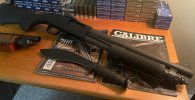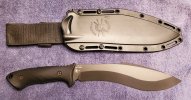Okay, so during this past year I became obsessed kukris and one tool options and I bought a bunch. Blades acquired within the last several months include:
Large Generic Kukri (12 in, 22.4 oz)
Kershaw camp 10 (10 in, 18.3 oz)
Kabar combat kukri (8.5 in, 13.95 oz)
Becker BK 10 (5.5 in, 12.4 oz)
Kabar Warthog (6.5 in, 16.8 oz)
Becker BK 16 (4.375 in, 6.4 oz)
Cold Steel Special Forces shovel
Condor Hudson Bay (8.5 in, 17.6 oz, *coming in the mail this week)
CRKT "Kuk" (10 in, 14.4 oz, *coming in the mail this week )
3 or 4 Mora's and Marttiini's
To make a long story short, I realized some things about blade weight (particularly) and shape, and I have to say -The Kabar Combat Kukri at 8.5 in. and juuust shy of 14 oz is such a beautifully functional and well designed blade. I took it out into the woods last weekend and, firstly, it chops like a BEAST. This knife can do A LOT if you have descent technique. Can't imagine what it would do with a good convex. Also, contrary to a traditional kukri, the blade goes pretty much down to the handle. The bolster is a little large for my taste and I would rather the blade went all the way to the top of the handle (I say that as someone who is essentially opposed to finger choils), but it is significantly better than a traditional kukri, which the first two inches of blade are essentially useless on. That is my one beef with traditional kukris -The gap in the first section of the blade and the lack of a finger guard.
Now, for me, if we're talking about a "one tool option", the blade must be 10in long and 18+ oz (between 18-22. Anything heavier and the tool can become a bit "un-wieldy", in my opinion). If I were thrown into a survival situation or a competition or whatever, I would reach for my camp 10 without hesitation. And, honestly, I struggle a little bit with the fact that I would use anything else for anything because that tool to me really is the essence of a one tool option, and I think it would be a good exercise to only use that for a while, BUT, the Combat Kukri is just soo well balanced and "handleable" -A total pleasure to use. I don't know how much they thought about it in the R and D phase, but they really landed on a beautifully functional blade. ONLY thing against it it that it doesn't have a lanyard hole! Sheath is fine for me. I actually like it a lot!
So, I'll say that after some time with the Combat Kukri, I am a little curious how a blade with a liiitle more weight and blade length would function -Which is why I'm so stoked to get my CRKT "kuk" in the mail!
Thanks for reading!
Take care!
-T
Large Generic Kukri (12 in, 22.4 oz)
Kershaw camp 10 (10 in, 18.3 oz)
Kabar combat kukri (8.5 in, 13.95 oz)
Becker BK 10 (5.5 in, 12.4 oz)
Kabar Warthog (6.5 in, 16.8 oz)
Becker BK 16 (4.375 in, 6.4 oz)
Cold Steel Special Forces shovel
Condor Hudson Bay (8.5 in, 17.6 oz, *coming in the mail this week)
CRKT "Kuk" (10 in, 14.4 oz, *coming in the mail this week )
3 or 4 Mora's and Marttiini's
To make a long story short, I realized some things about blade weight (particularly) and shape, and I have to say -The Kabar Combat Kukri at 8.5 in. and juuust shy of 14 oz is such a beautifully functional and well designed blade. I took it out into the woods last weekend and, firstly, it chops like a BEAST. This knife can do A LOT if you have descent technique. Can't imagine what it would do with a good convex. Also, contrary to a traditional kukri, the blade goes pretty much down to the handle. The bolster is a little large for my taste and I would rather the blade went all the way to the top of the handle (I say that as someone who is essentially opposed to finger choils), but it is significantly better than a traditional kukri, which the first two inches of blade are essentially useless on. That is my one beef with traditional kukris -The gap in the first section of the blade and the lack of a finger guard.
Now, for me, if we're talking about a "one tool option", the blade must be 10in long and 18+ oz (between 18-22. Anything heavier and the tool can become a bit "un-wieldy", in my opinion). If I were thrown into a survival situation or a competition or whatever, I would reach for my camp 10 without hesitation. And, honestly, I struggle a little bit with the fact that I would use anything else for anything because that tool to me really is the essence of a one tool option, and I think it would be a good exercise to only use that for a while, BUT, the Combat Kukri is just soo well balanced and "handleable" -A total pleasure to use. I don't know how much they thought about it in the R and D phase, but they really landed on a beautifully functional blade. ONLY thing against it it that it doesn't have a lanyard hole! Sheath is fine for me. I actually like it a lot!
So, I'll say that after some time with the Combat Kukri, I am a little curious how a blade with a liiitle more weight and blade length would function -Which is why I'm so stoked to get my CRKT "kuk" in the mail!
Thanks for reading!
Take care!
-T



